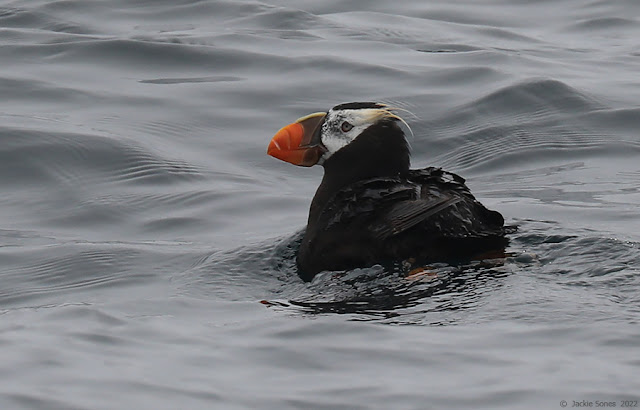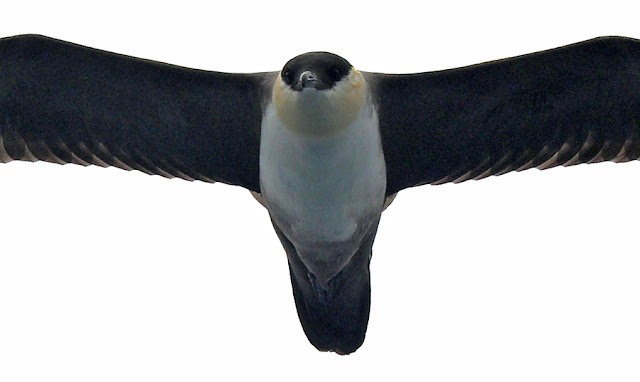Waxing crescent moon photographed from Cotati on 30 August 2022.
Wednesday, August 31, 2022
Tuesday, August 30, 2022
Gray on gray
Monday, August 29, 2022
Lions, porpoises, and a mystery
Several Steller Sea Lions (Eumetopias jubatus) swimming by while we were offshore on 21 August 2022.
And although we saw several small groups of porpoises, here's the only photo that came out of a Dall's Porpoise (Phocoenoides dalli). They're incredibly fast:
P.S. In part I thought I'd show these marine mammals tonight because I also had an interesting observation from shore today. Around midday it's possible I saw a group of Risso's Dolphins (Grampus griseus) swimming south past Bodega Head towards Point Reyes. I'm not 100% certain, but I feel that it's likely, so if you're near the coast, keep your eyes open for tall, curved fins.
P.P.S.
And I'll add a few more photos to this post. This is just for fun,
and also in case anyone can help provide input re: an identification.
During the boat trip I turned to see an animal at the surface that I
couldn't identify. I thought I saw a somewhat
bumpy back and then a gap and a bulbous head. At sea I thought through the mammals it could
possibly be, even something like a Pygmy Sperm Whale. I snapped a few quick
photos in the area, and I did capture something, but it was just a glimpse (a "Loch Ness" view?). I won't bias you, but I'll tell you what I'm thinking
below the photos. [You can click on the images for larger versions.]
This is the same photo as the last one, but showing a wider view:
Sunday, August 28, 2022
Offshore Brown Booby
Well, these photos didn't come out very well, but I think they're still the best photos I have of a Brown Booby (Sula leucogaster) in this area. These were taken during an offshore pelagic boat trip on 21 August 2022. (I think we were in Marin County when we encountered this bird.) Brown Boobies are rare in Marin and Sonoma counties (they generally have a more tropical distribution), so I'm sharing a couple of pictures for the record, although I'm sure other folks on the boat trip ended up with better photos!
Friday, August 26, 2022
Fins and flukes
I don't have much time tonight, but here are a few Humpback Whale (Megaptera novaeangliae) photos from the offshore boat trip on 21 August 2022.
This is the same whale showing its flukes:
Thursday, August 25, 2022
Golden tufts
Tufted Puffin (Fratercula cirrhata), offshore, 21 August 2022
And here's a fun view of those golden tufts from behind:
Wednesday, August 24, 2022
Summer treats
A Black-footed Albatross (Phoebastria nigripes) approaching a large piece of squid just below the surface.
Then a second individual expressed interest, too:
When a third came along, things started to get a little fussy:
Tuesday, August 23, 2022
Overhead
Well, I'm a little disappointed to report that I had some issues with my camera settings on the boat trip. I'll still have some photos to share for the record, but the quality is a bit off. Lesson learned! Maybe this jaeger was trying to tell me something...
More photos to come!
Monday, August 22, 2022
Greyhounds of the sea
Okay, here you go, more Fin Whale photos! The first two pictures (above and below) show their long backs. The raised area surrounding the blowholes is also visible.
Sunday, August 21, 2022
Going, going, gone!
I joined an offshore boat trip today (21 August 2022) on the New Sea Angler. We made it ~30 miles off shore and visited Cordell Bank and Bodega Canyon.
One of the highlights was a small group of Fin Whales (Balaenoptera physalus). I'll show more pictures later (of Fin Whales and other species), but for now I thought I'd share these fluke shots.
I haven't seen Fin Whales very often in this area (but see the previous sighting in the post on 31 July 2016). And it's rare for them to show their flukes, so here you go!
Wednesday, August 17, 2022
Magic cape
I love seeing this sea hare, especially up close, when you can see the bright blue-green spots (and tiny orange dots, too, if you look carefully). Meet Hedgpeth's Sea Hare (Elysia hedgpethi)! [I posted about this species a few years ago — see "Not a flatworm!" on 26 June 2013.]
Last week, my first view of this individual was very different. Under water, they are transformed into the beautiful sea hare in the first photo. But out of water, they look like a flattened green/black blob on the rock:
Tuesday, August 16, 2022
Little lizard
When we got home from work tonight, this tiny lizard ran across our path. It was only ~6 cm (~2.5 inches) long, including the tail. I think it's a juvenile Western Fence Lizard (Sceloporus occidentalis), but let me know if you have a different opinion.
Monday, August 15, 2022
Eating peanuts
Here's a fun story. In Monterey County, I came across an Ida's Mitra snail (Atrimitra idae, formerly Mitra idae). Although we see their shells occasionally in Bodega Bay, I haven't seen a live snail in the field, so I was excited to find one.
I have read that Ida's Mitra specializes on eating an unusual prey item — peanut worms (sipunculans). I've always been curious about how that works, since peanut worms often live deep within rock crevices.
After photographing this individual, I looked up to see a second Ida's Mitra not too far away. I took a quick photo and noticed something brown that I wasn't sure about. I was under the impression that Ida's Mitra's body was primarily white, so I wasn't sure what the brown part might be. Here's the next photo and then a second even closer image from a slightly different angle:
And I also encountered a very pretty juvenile snail:
Sunday, August 14, 2022
Visiting the cleaners
Looking around in the low intertidal zone in Monterey County this week, I peeked over a rock to see these striking striped shrimp. Beautiful!
I kept scanning and found a handful of these shrimp in a tidepool. This was my first view (below). [Don't miss the smaller individual at the bottom.]
These are fairly large shrimp — the largest individual I saw was ~7 cm (~3 inches) long. They have a grayish translucent background color and bold red striping. Another notable feature is the extremely long antennae.





















































